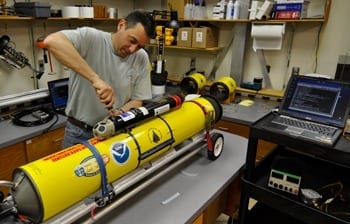Two robots equipped with instruments designed to “listen” for the calls of baleen whales detected nine endangered North Atlantic right whales in the Gulf of Maine last month.
The robots reported the detections to shore-based researchers within hours of hearing the whales (i.e., in real time), demonstrating a new and powerful tool for managing interactions between whales and human activities.
The team of researchers, led by Woods Hole Oceanographic Institution (WHOI) scientists Mark Baumgartner and Dave Fratantoni, reported their sightings to NOAA, the federal agency responsible for enforcing the Marine Mammal Protection Act. NOAA Fisheries Service, in turn, put in place on Dec. 5 a “dynamic management area,” asking mariners to voluntarily slow their vessel speed to avoid striking the animals.
The project employed ocean-going robots called gliders equipped with a digital acoustic monitoring (DMON) instrument and specialized software allowing the vehicle to detect and classify calls from four species of baleen whales – sei, fin, humpback, and right whales. The gliders’s real-time communication capabilities alerted scientists to the presence of whales in the research area, in the first successful use of technology to report detections of several species of baleen whales from autonomous vehicles.
The oceanographic research project was underway from Nov. 12 through Dec. 5, operating in an area called the Outer Fall, about sixty miles south of Bar Harbor, Me., and 90 miles northeast of Portsmouth, NH. Right whales are thought to use this area every year between November and January as a mating ground.
Two gliders were deployed by Ben Hodges and Nick Woods, also of WHOI, on Nov. 12 from the University of New Hampshire’s 50-ft research vessel, the Gulf Challenger. The vehicles surveyed the area for two weeks, sending data to the researchers every two hours via satellite, prior to the scientific team’s arrival Nov. 28 on the University of Rhode Island’s research vesselEndeavor. The gliders continued to survey for another week before being recovered by the Endeavor on Dec. 4. “We put two gliders out in the central Gulf of Maine to find whales for us,” says Baumgartner, who specializes in baleen whale and zooplankton ecology. “They reported hearing whales within hours of hitting the water. They did their job perfectly.”
Using the gliders’s reconnaissance data and continued real-time updates, the science team was able to locate whales in just a few hours of searching. “We found our first right whale on the first day that we were surveying in decent weather conditions because the gliders were up there doing the leg work for us, to tell us where the animals were in real time,” says Baumgartner.
The innovative whale detection system provides conservation managers with a cost-effective alternative to ship- or plane-based means of identifying the presence of whales, and gives whale ecologists new tools for understanding large animals that spend most of their lives out of human eyesight below the sea surface.
Whale researchers want to learn what draws whales to this part of the ocean during the late fall and winter. However, high winds and rough seas typical of that time of year make studying the animals very difficult.
“This presents a huge knowledge gap,” says Baumgartner.
The labor-intensive work of surveying for whales, overseen by NOAA, is usually done by human observers on ships or airplanes, and is limited by the conditions at sea.
“We’ve been doing visual based surveys for a long time – either from a plane or a boat. They have a lot of value, but they are limited, especially at certain times of the year,” says Sofie Van Parijs, leader of the Passive Acoustic Research Group at NOAA’s Northeast Fisheries Science Center (NEFSC). “These gliders provide a great complement to this system. Knowing where right whales are helps you manage interactions between an endangered species and the human activities that impact those species.”
The success of the project is a result of years of productive collaboration among engineers, biologists and physical oceanographers at WHOI, scientists at the NEFSC Protected Species Branch in Woods Hole, and federal funders like the Office of Naval Research and NOAA’s Applied Science and Technology Working Group Program. The gliders are operated by Fratantoni, a physical oceanographer; the DMON acoustic monitoring instrument was developed by WHOI engineers Mark Johnson and Tom Hurst; and Baumgartner, who has nearly a decade of experience identifying whale calls, wrote software for the DMON to enable it to recognize unique calls of sei, fin, humpback, and right whales, and to keep a tally of when and where it heard each call. By integrating the DMON into Fratantoni’s gliders, the team had the ability to search large areas of the ocean and to receive data in real time.
“No one of us could’ve done this project alone. But by teaming up, we created a really nice group of people with expertise that was tailor made for this problem,” says Baumgartner. “Now, we can know that there’s an animal in a particular part of the ocean within hours of a call being made, as opposed to months later,” when the instruments have finally been retrieved and the data has been reviewed.
Gliders – approx. six-foot-long, torpedo-shaped autonomous vehicles with short wings – have been in use by oceanographers for about a decade. They move up, down, and laterally in a sawtooth pattern through the water by changing their buoyancy and using their wings to provide lift. Battery powered and exceptionally quiet in the water, the gliders are equipped with an underwater microphone on the underside of the vehicle near its wings, and an iridium satellite antenna on the tail section. The vehicle surfaces every few hours to get a GPS position and transmit data to shore-side computers.








